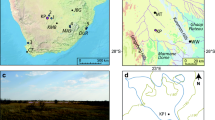Abstract
The Jingshuiwan Paleolithic site occupies the second terrace on the right bank of the Yangtze River. The lithic assemblage is characterized by choppers and scrapers made on pebbles and large flakes—the typical lithic industry of South China. Deposits of the site are mainly composed of fluvial sediments. Quartz grains extracted from these fluvial sediments from which the artifacts were uncovered were dated using the optically stimulated luminescence/single-aliquot regenerative-dose technique. The dating results show that ancient human activities at this site took place in the early Upper Pleistocene (ca. 70 ka). The successful age analysis of the Jingshuiwan site is considered as a major break-through in chronological analysis of Paleolithic open site in the Three Gorges region and even in South China. The dates obtained help to establish a more complete chronological framework of the Paleolithic cultural sequence in the region, and bear significant implications in studying modern human origins in China.
Similar content being viewed by others
References
Wei Q, Lin S L, Li Y, et al. Survey of relics of the Old Stone Age and ancient human vertebral animal. In: China Three Gorges Construction Yearbook (in Chinese). Yichang: China Three Gorges Construction Press, 1997. 100–109
Pei S W, Feng X W, Chen F Y, et al. New advances in Paleolithic archeological investigations in the Three Gorges region, China. In: Deng T, Wang Y, eds. Proceedings of the Eight Annual Meeting of the Chinese Society of Vertebrate Paleontology (in Chinese). Beijing: China Ocean Press, 2001. 197–208
Pei S W, Gao X, Feng X W, et al. Preliminary study on Jingshuiwan Paleolithic site, Three Gorges region. Acta Anthropologica Sinica (in Chinese), 2003, 22(4): 261–278
Aitken M J. An Introduction to Optical Dating: the Dating of Quaternary Sediments by the Use of Photon-Stimulated luminescence. Oxford: Oxford University Press, 1998
Pavlov P, Svendsen I, Indrelid S. Human presence in the European Arctic nearly 40000 years ago. Nature, 2001, 413: 64–67
Christopher S H, Francesco D E, Royden Y, et al. Emergence of Modern Human Behavior: Middle Stone Age Engravings from South Africa. Science, 2002, 295: 1278–1280
Bowler J M, Johnston H, Olley J, et al. New ages for human occupation and climatic change at Lake Mungo, Australia. Nature, 2003, 421: 837–840
Prescott J R, Hutton J T. Cosmic ray contributions to dose rates for luminescence and ESR dating: large depths and long-term time variations. Radiation Measurements, 1994, 23: 497–500
Adamiec G, Aitken M J. Dose-rate conversion factors: update. Ancient TL, 1998, 16: 37–50
Mejdahl V. Thermoluminescence dating: beta-dose attenuation in quartz grains. Archaeometry, 1979, 21: 61–72
Bøtter-Jensen L, Bulur E, Duller G A T, et al. Advances in luminescence instrument systems. Radiation Measurement, 2000, 32: 523–528
Murray A S, Wintle A G. Luminescence dating of quartz using an improved single-aliquot regenerative-dose protocol. Radiation Measurements, 2000, 32: 57–73
Zhang J F, Li S, Tso M Y W. Assessment of bleaching of K-feldspar grains. Radiation Measurements, 2001, 33: 103–108
Zhang J F, Zhou L P, Yue S Y. Dating fluvial sediments by optically stimulated luminescence: selection of equivalent doses for age calculation. Quaternary Science Reviews, 2003, 22: 1123–1129
Wallinga J. Optically stimulated luminescence dating of fluvial deposits: a review. BOREAS, 2002, 31: 303–322
Li S H. Optical dating: insufficiently bleached sediments. Radiation Measurements, 1994, 23: 563–567
Chen T M. A review and prospect of chronological studies for Paleolithic archeology in China. Acta Archaeologica Sinica (in Chinese), 1988, 3: 357–367
Shen G J. Origin of modern humans: chronological evidence from hominid fossil localities in Southern China. Earth Science Frontiers (in Chinese), 2004, 11(2): 543–548
Feng X W, Pei S W, Chen F Y. A study on Yandunbao site, fengdu, Three Gorges region. Acta Anthropologica Sinica (in Chinese), 2003, 22(3): 177–191
Huang W, Ciochon R, Gu Y M, et al. Early Homo and associated artifacts from Asia. Nature, 1995, 378: 275–278
Zhang S S. Advances in Chinese Paleolithic archeology in the past 20 years and some comments. Quaternary Sciences (in Chinese), 2002, 22(1): 11–19
Jin L, Su B. Natives or immigrants: modern human origin in east Asia. Nature Genetics, 2000, 1: 126–133
Ke Y, Su B, Song X, et al. African origin of modern humans in East Asia: A tale of 12000 Y chromosomes. Science, 2001, 292: 1151–1153
Ke Y H, Su B, Li H Y, et al. Chromosome Y genetic evidence sustain Chinese modern human origin from Africa. Chin Sci Bull, 2001, 46(5): 411–414
Huang W P, Gu Y M, Ciochon R, et al. Whose teeth? Nature, 1996, 381: 202
Gao X, Huang W B, Xu Z Q, et al. 120–150 ka human tooth and ivory engravings from Xinglongdong Cave, Three Gorges region, South China. Chin Sci Bull, 2004, 49(2): 175–180
Wu X Z. On the origin of modern humans in China. Quaternary International, 2004, 117: 131–140
Author information
Authors and Affiliations
Corresponding author
About this article
Cite this article
Pei, S., Zhang, J., Gao, X. et al. Optical dating of the Jingshuiwan Paleolithic site of Three Gorges, China. CHINESE SCI BULL 51, 1334–1342 (2006). https://doi.org/10.1007/s11434-006-1334-7
Received:
Accepted:
Issue Date:
DOI: https://doi.org/10.1007/s11434-006-1334-7



